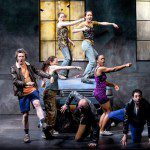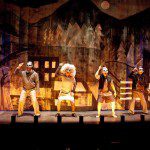D’oh: Excellent ‘Mr. Burns’ in a Post-Electric World
By • August 10, 2012 0 1705

Ever wonder why Woolly Mammoth Theatre Company and artistic director Howard Schalwitz refuse to lose their edge, get stale, play safe, stay full of surprises that pop out consistently out of their burlap sack that they call theater?
Go see “Mr. Burns, a Post-Electric Play,” by the astonishingly gifted playwright Ann Washburn and wonder no more. Washburn induces a state of wonder, provokes, makes you squirm and laugh, and think about tomorrow, if you’ve stopped doing that.
To be fair, “Mr. Burns” won’t be everyone’s cup of gizmo tea, but then nothing at Woolly ever is. I watched what seemed to be the beginnings of quite a lengthy argument between a couple who saw the action before them on the stage quite differently, the kind of thing that can only happen at a theater, a political debate, a demonstration or a football game.
Washburn accomplishes this by imagining a post-apocalyptic world—to climax Woolly’s apocalyptic-themed season—inhabited by a rabbity group of survivors in an America where the grid has broken down, nuclear generators have erupted, and the population has been reduced to an unforgivingly small number. How would people—any sort of people—react to this, what would they choose to remember, cherish, reject? What cultural artifacts would remain within them just waiting to be retold?
How about “The Simpsons”?
That’s right, “The Simpsons,” the hugely popular adultish cartoon sitcom which created a host of fans, some of them fanatics on the Star Trek order, with a large volume of shows to embrace and clutch dearly to their hearts, like talking teddy bears. That’s what a group of disparate but not yet desperate survivors more or less thrown together in a woody Northwest area begin to do, at first starting to grapple with their shared memory of “The Simpsons,” then slowly focusing on a particularly cherished and legendary episode, a parody of the Martin Scorcese’s remake of “Cape Fear,” starring Robert DeNiro, called “Cape Feare.”
You don’t have to (although it must surely help) be a “Simpsons” fan—I have never watched a full episode but have friends who had a Bart Simpson puppet in their window—to get what’s happening or even join in. It’s people—frightened, tentative, afraid to let go of the past which has just been essentially destroyed—trying to recreate it, as civilizations always have. By remembering the sleekly villainous Sideshow Bob or Bart cowering in a movie theatre in front of him because of death threats, they remember moments. More than that, these people, these characters take it further, in later years, as they form a traveling performing company—reminiscent of traveling carnivals, mystery plays, circus and amateur theater groups of yore—trading in memories of “Simpsons” scripts, trying at the same time to rebuild a culture.
It sounds odd—and it is creepy weird and touching—but it’s also amid all the outrageousness, a portrait of something important, an illustration of how ordinary folks embrace a culture of sorts. It may be that, as a society, we might not remember high culture, but some form of culture broadly shared, not Ophelia necessarily and not Homer’s Illiad but Homer Simpson.
As a group, the characters are hard to remember as named individuals, but impossible to forget as people. Initially, they carry with them guns, booklets with lists of names of people—relatives, friends, lovers, the local mechanic, who might have survived. We don’t know who they are exactly, what they did, where they specifically lived, what or who they lost. They sear themselves into our own dreams by the way they behave and that’s a function of the gifts of the actors.
There is, for instance, the magnificently-voiced Gibson, played with awesome affect by Chris Genebach—he’s tall, bald, gleaming almost, with a way of speaking that echoes manly singing, with the added plus that he can do Gilbert and Sullivan. There’s the thin, bounding Maria, played movingly, like some wounded Jackie-in-the-Box windup ballerina by Jenna Sokolowski, and the affecting, singular and insistent Matt, played by Steve Rose, and Jenny, hesitant, pushy, kind of daffy and sexy, and mysteriously affecting as played by Kimberly Gilbert, a Woolly regular who keeps getting better and better every year.
Much of this is very funny—the attempts to reproduce commercials of the period, to wit — and profoundly funny-sad. Consider a moment when one of the characters insists that Homer and Bart be authentic and real. “They’re cartoons for God’s sake,” another insists. “You can’t hurt them.” It’s a big issue: what we invest, how much of our hearts and souls, in our culture.
The test of the play is the last part in which we see the real thing, or as close as it gets: Mr. Burns (the people-hating, sleazy and greedy nuclear plant owner in the TV series) revealed as the villain, and the Simpsons in horrible peril. Is it real, or is it memories?
How we respond as individuals and members of a group—we, the audience—is what decides the fate of the play, of course, which is the first step toward renewal in a post-apocalyptic world—or in a world that is changing faster than the speed of sight.
“Mr. Burns” runs at the Woolly Mammoth Theatre at 641 D Street, N.W., through July 1.
- The cast of Mr. Burns,a post-electric play. | Scott Suchman



